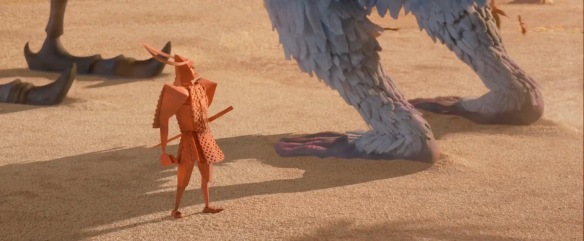The majority of this review is going to deal with the dualities that permeated Kubo and the Two Strings from tones, to thematics, to sensibilities, to even the music, but before I start speaking about that, the very first thing that needs to be said about this movie is that it is gorgeous. Travis Knight and his crew of artists and animators have brought forth a thing of absolute beauty with vivid color schemes, fantastic designs, and incredible attention to detail. You forget while watching Kubo and the Two Strings that what you are seeing is stop motion and not hand drawn or CGI animation (though, I suspect many of the backgrounds were, in fact, done with CGI). This is more than just a single level beyond what Tim Burton wowed us with when he gave us The Nightmare Before Christmas and The Corpse Bride, what Knight and company give us often seems impossible, but there it is. I have no problem with giving away the end of this review by saying that I will most definitely be buying this movie on Blu-Ray, but before I watch the film itself, I will have to watch the making of featurettes because what these animators have managed to accomplish astonished me so much that what I saw does not always seem plausible, and I have to know how they did it.
Kubo and the Two Strings is a movie that, while it never mentions Yin-Yang, is infused with duality after duality. It’s a film written with Western plot structure, but with Eastern stylings. Western stories are all about, well, telling a story. Most people reading this will know it as the only story telling style there is. Plot has a structure and a rhythm, a beginning, a middle, and an end which all come at around the same time throughout the life cycle of a story, and have a pattern all Western audiences not only find familiar, but understand so intuitively that to tell a story any other way just doesn’t feel right. Eastern story telling is quite different. Structure, plot, and character all take a back seat to what I can only describe as experience. The emotions a story evokes, the message it teaches, the philosophy it espouses are all more important to an Eastern story than things like character consistencies or plot points hitting at appropriate times. In Eastern stories things happen not to further a plot, necessarily, but to make the audience react. Kubo and the Two Strings manages to be both story telling styles at once as it uses Western plot structure with its 3 act story line that rises and falls right when a Western audience would expect but it doesn’t bother overly much with explanation or internal logic, instead giving us characters and settings that don’t need to be explained or even understood in order to entertain and engage us. Where does the Moon King come from, and what is he really? A god, wizard, spirit? It doesn’t matter ultimately to the story so we’ll never know. Many of our main characters and places just are, and that’s okay because overemphasis on exposition can often just be a distraction.

In a Western movie, I’d be a cheap plot device. In an Eastern movie, I’m part of the experience.
Another duality is that is a movie made both for children and adults, and not in the normal way people talk about when discussing family movies. For the children, the humor in Kubo and the Two Strings is incredibly corny, to an eye rolling, dad joke degree. It’s not too badly overdone, but I found myself groaning often at the attempts at humor throughout the film while also recognizing that young children would probably find much of it hilarious in the same way they love repeating jokes that were once upon a time found on the side of a Dixie cup (I’m showing my age). The characters are also aimed at a younger audience with the scary never being too terribly scary and the protagonists always being a child, a parental figure, or over the top comic relief. However, Kubo and the Two Strings is never afraid to shy away from adult issues like death, abandonment, grief, and responsibility. While Kubo and the Two Strings never becomes grotesque, it is very often dark and earnest and could quite possibly be a bit much for children of an age young enough to appreciate the humor in the movie. This is definitely one adults will have to watch with their children because they will have a good many questions afterward, the adults may even find themselves with one or two themselves.
The plot itself also has a great many yin-yang elements, most of which can’t be talked about in any great detail or the movie would be spoiled. The story deals with both the natural and the spiritual world. Day and night play important roles. Even something as seemingly one dimensional as good and evil are shown to have two sides, and there are, of course, the titular two strings…

It’s almost as if the title means something.
Kubo and the Two Strings is a movie that demands you expand the way you think and feel in order to enjoy and understand it in its entirety. If you are willing to try to be both adult and child, believer and cynic, thinker and feeler, then Kubo will have a lot to offer. If you insist on viewing it with tunnel vision, however, then you are going to find much of the story annoying and confusing. Both Kubo the child and Kubo the movie are beings that exist in two worlds at once. No matter how open minded you decide to be, however, you will at least get to experience the most gorgeous animation to grace the big screen in some time.
Rating: 8.2 out of 10
